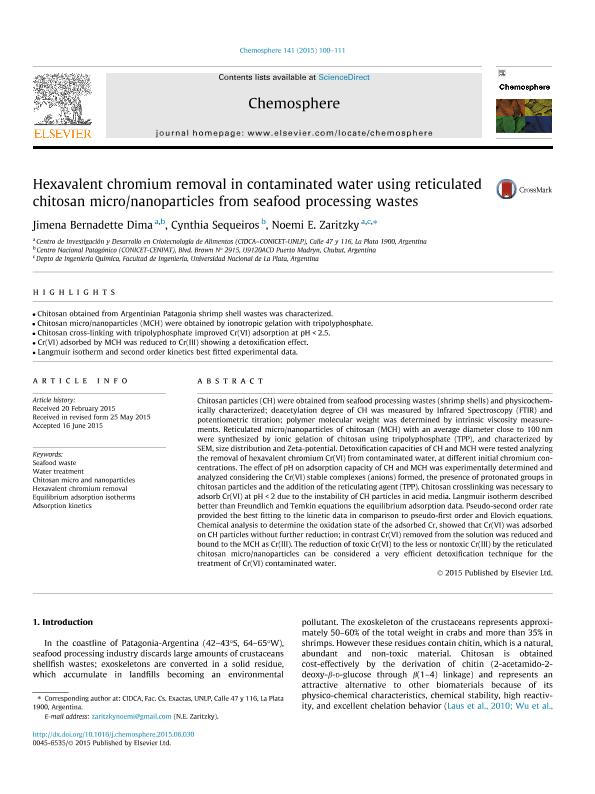Mostrar el registro sencillo del ítem
dc.contributor.author
Dima, Jimena Bernadette

dc.contributor.author
Sequeiros, Cynthia

dc.contributor.author
Zaritzky, Noemi Elisabet

dc.date.available
2017-10-23T19:57:39Z
dc.date.issued
2015-07
dc.identifier.citation
Dima, Jimena Bernadette; Sequeiros, Cynthia; Zaritzky, Noemi Elisabet; Hexavalent chromium removal in contaminated water using reticulated chitosan micro/nanoparticles from seafood processing wastes; Elsevier; Chemosphere; 141; 7-2015; 100-111
dc.identifier.issn
0045-6535
dc.identifier.uri
http://hdl.handle.net/11336/26949
dc.description.abstract
Chitosan particles (CH) were obtained from seafood processing wastes (shrimp shells) and physicochemically characterized; deacetylation degree of CH was measured by Infrared Spectroscopy (FTIR) and potentiometric titration; polymer molecular weight was determined by intrinsic viscosity measurements. Reticulated micro/nanoparticles of chitosan (MCH) with an average diameter close to 100. nm were synthesized by ionic gelation of chitosan using tripolyphosphate (TPP), and characterized by SEM, size distribution and Zeta-potential. Detoxification capacities of CH and MCH were tested analyzing the removal of hexavalent chromium Cr(VI) from contaminated water, at different initial chromium concentrations. The effect of pH on adsorption capacity of CH and MCH was experimentally determined and analyzed considering the Cr(VI) stable complexes (anions) formed, the presence of protonated groups in chitosan particles and the addition of the reticulating agent (TPP). Chitosan crosslinking was necessary to adsorb Cr(VI) at pH. <. 2 due to the instability of CH particles in acid media. Langmuir isotherm described better than Freundlich and Temkin equations the equilibrium adsorption data. Pseudo-second order rate provided the best fitting to the kinetic data in comparison to pseudo-first order and Elovich equations. Chemical analysis to determine the oxidation state of the adsorbed Cr, showed that Cr(VI) was adsorbed on CH particles without further reduction; in contrast Cr(VI) removed from the solution was reduced and bound to the MCH as Cr(III). The reduction of toxic Cr(VI) to the less or nontoxic Cr(III) by the reticulated chitosan micro/nanoparticles can be considered a very efficient detoxification technique for the treatment of Cr(VI) contaminated water.
dc.format
application/pdf
dc.language.iso
eng
dc.publisher
Elsevier

dc.rights
info:eu-repo/semantics/openAccess
dc.rights.uri
https://creativecommons.org/licenses/by-nc-sa/2.5/ar/
dc.subject
Adsorption Kinetics
dc.subject
Chitosan Micro And Nanoparticles
dc.subject
Equilibrium Adsorption Isotherms
dc.subject
Hexavalent Chromium Removal
dc.subject
Seafood Waste
dc.subject
Water Treatment
dc.subject.classification
Bioprocesamiento Tecnológico, Biocatálisis, Fermentación

dc.subject.classification
Biotecnología Industrial

dc.subject.classification
INGENIERÍAS Y TECNOLOGÍAS

dc.title
Hexavalent chromium removal in contaminated water using reticulated chitosan micro/nanoparticles from seafood processing wastes
dc.type
info:eu-repo/semantics/article
dc.type
info:ar-repo/semantics/artículo
dc.type
info:eu-repo/semantics/publishedVersion
dc.date.updated
2017-07-27T12:47:57Z
dc.journal.volume
141
dc.journal.pagination
100-111
dc.journal.pais
Países Bajos

dc.journal.ciudad
Ámsterdam
dc.description.fil
Fil: Dima, Jimena Bernadette. Provincia de Buenos Aires. Gobernación. Comisión de Investigaciones Científicas. Centro de Investigación y Desarrollo en Criotecnología de Alimentos. Consejo Nacional de Investigaciones Científicas y Técnicas. Centro Científico Tecnológico Conicet - La Plata. Centro de Investigación y Desarrollo en Criotecnología de Alimentos. Universidad Nacional de La Plata. Facultad de Ciencias Exactas. Centro de Investigación y Desarrollo en Criotecnología de Alimentos; Argentina. Consejo Nacional de Investigaciones Científicas y Técnicas. Centro Científico Tecnológico Conicet - Centro Nacional Patagónico; Argentina
dc.description.fil
Fil: Sequeiros, Cynthia. Consejo Nacional de Investigaciones Científicas y Técnicas. Centro Científico Tecnológico Conicet - Centro Nacional Patagónico. Centro para el Estudio de Sistemas Marinos; Argentina
dc.description.fil
Fil: Zaritzky, Noemi Elisabet. Provincia de Buenos Aires. Gobernación. Comisión de Investigaciones Científicas. Centro de Investigación y Desarrollo en Criotecnología de Alimentos. Consejo Nacional de Investigaciones Científicas y Técnicas. Centro Científico Tecnológico Conicet - La Plata. Centro de Investigación y Desarrollo en Criotecnología de Alimentos. Universidad Nacional de la Plata. Facultad de Ciencias Exactas. Centro de Investigación y Desarrollo en Criotecnología de Alimentos; Argentina. Universidad Nacional de La Plata. Facultad de Ingeniería. Departamento de Ingeniería Química; Argentina
dc.journal.title
Chemosphere

dc.relation.alternativeid
info:eu-repo/semantics/altIdentifier/url/http://www.sciencedirect.com/science/article/pii/S0045653515006499
dc.relation.alternativeid
info:eu-repo/semantics/altIdentifier/doi/https://doi.org/10.1016/j.chemosphere.2015.06.030
Archivos asociados
